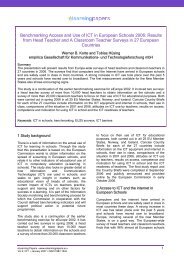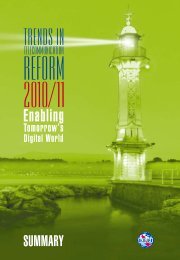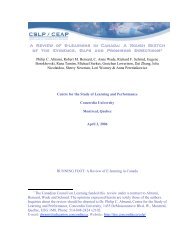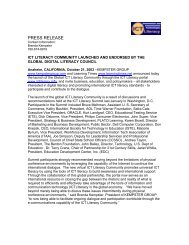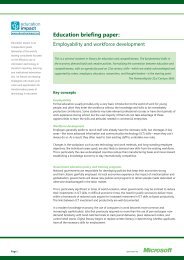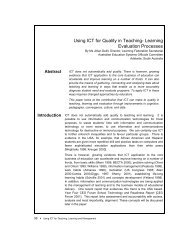147 pages pdf - ICT Digital Literacy
147 pages pdf - ICT Digital Literacy
147 pages pdf - ICT Digital Literacy
Create successful ePaper yourself
Turn your PDF publications into a flip-book with our unique Google optimized e-Paper software.
Testing Here, External Testing There, Quality Assurance Everywhere<br />
#438: Be Prepared: Think Contingency<br />
Ask "What if?" (the constructive pessimism technique). For example, locate a backup system --<br />
just in case your computer goes down -- as breakdowns will occur. It's more a question of<br />
"when" rather than "if." Also, be familiar with multiple Operating Systems as well as with various<br />
web browsers (Netscape, Microsoft Internet Explorer, etc.), email programs and word<br />
processors (e.g., MS Word, Word Perfect). The key is flexibility-- know (and test) more than<br />
ONE way to accomplish a task.<br />
Ross Hodgkinson<br />
Tack Training America<br />
#439: Testing, Simply Put<br />
Be sure to create evaluation questions that are linked to the course content. And use beta<br />
testers before rolling out full scale.<br />
Eduardo Ramos<br />
Instituto Infnet<br />
#440: One Last Edit: The Comma Challenge<br />
After applying a "final" edit, always click through the WBT again to make sure it works even if the edit was<br />
small. One of our development tools causes the WBT program to stop cold if a comma is used in the<br />
answer choices to a question. Definitely a limitation to the program but one we know about and work<br />
around. One time we added an additional question at the last minute before launching and even though<br />
we went through months of testing and editing, one comma stopped the whole launch.<br />
Kevin Harrington<br />
Prudential Financial<br />
#441: Steering The Client Through The Process For Results<br />
e-Learning courseware development is not the same as any other software development. It is<br />
much more iterative inherently as a process. And many a times the client him/herself may not<br />
be very clear of the requirements. So have a process which incorporates ongoing reviews and<br />
validations at the client end. This will assure you a higher level of quality.<br />
Amit Garg<br />
#442: How Should We Test? Let Me Count The Ways<br />
Be sure to build enough time in your schedule to pilot the prototype of the training with the intended<br />
audience. Just observing where they get stuck or caught in a loop will help to expose problematic areas<br />
that the instructional designers/developers may overlook because they're not Subject Matter Experts.<br />
Jennifer Adkins<br />
Quest Diagnostics<br />
#443: Hard To Use = No Use<br />
Run usability tests on your course deliverables.<br />
Dr. Erwin Bratengeyer<br />
Donau-Universitaet Krems<br />
#444: Test And Listen<br />
Test your course in all its stages of development. Make sure that different people, from different<br />
segments of the target audience, are represented in the sample on whom you test your course.<br />
Hear the feedback and really take it seriously. Be willing to revise and then revise again until<br />
you are confident that you have addressed all key feedback. This doesn't mean that you have to<br />
incorporate everyone's changes, but it does mean that you should be able to doument why you<br />
included specific changes and why you chose not to include others.<br />
Mary Bollash<br />
United Technologies<br />
701 e-Learning Tips by The MASIE Center www.masie.com 88



